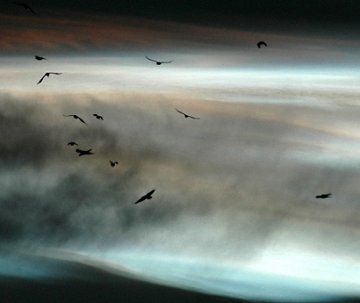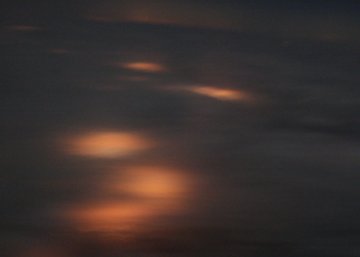 Where's Saturn? Is that a UFO--or the ISS? What's the name of that star? Get the answers from mySKY--a fun new astronomy helper from Meade. Where's Saturn? Is that a UFO--or the ISS? What's the name of that star? Get the answers from mySKY--a fun new astronomy helper from Meade. CONVERGING PLANETS: Awake at dawn? Go outside and look at Venus and Jupiter. The two brightest planets are converging in the southeastern sky for a spectacular close encounter on Feb. 1st. By the end of the month, the two planets will be so close together, you can hide them behind the tip of your index finger held at arm's length. That's worth waking up for. Sky maps: Jan. 31, Feb 1. 2, 3, 4. NACREOUS ABUNDANCE: Veteran sky watchers in Scandinavia can hardly believe their eyes. At the end of the day, the sun sets as usual, the sky grows dark, but instead of stars, nacreous clouds appear. "We've had four displays in the past week alone," reports Håkon Dahle of Oslo, Norway, who caught a flock of birds backlit by a glowing veil of pearly color last night: 
Nacreous clouds are supposed to be rare, but lately they've rolled across the Arctic circle with puzzling regularity. "It's almost hard to believe," says Swedish photographer P-M Hedén whose Jan. 25th photos nicely highlight the difference between ordinary clouds, scudding dark and low through the twilight, and the pearly-colored nacreous clouds floating airily overhead. "The clouds were all over the sky today - from dawn til dusk," adds Morten Ross of Oslo, Norway. "Incredible!" Also known as "Mother of Pearl" clouds, nacreous clouds are peppered with tiny ice crystals that blaze with iridescent color when struck by light from the setting sun. It is these crystals that make nacreous clouds rare: they require exceptionally low temperatures of minus 85 Celsius (-120 F) to form. Nacrous clouds float 9 to 16 miles high, curling and uncurling hypnotically as they are stretched in and out by atmospheric gravity waves. Why the sudden abundance? No one knows, neither why the clouds have come nor when they will go. Sky watchers from Scandinavia to Alaska should remain alert for more in the nights ahead. LIGHT POLLUTION FROM 24,000 FT: On Jan. 15th, Rick Stankiewicz looked out the window from his seat aboard a night flight from Toronto to Thunder Bay, Ontario. "I expected to see a blank slate of clouds," he says. "Instead I noticed orange glowing patches." 
"It was all too obvious what I was observing," continues Stankiewicz. "These glowing cloud patches were indicators of light pollution from communities across southwestern Ontario. This misdirected and wasted light was filtering through the cloud deck to my airplane window at 24,000 ft. I was amazed at their number; within minutes, I counted dozens. I used my digital camera (a Canon 400D) to capture as best as I could what I saw. There is no denying it; societies beacons of light are also their signposts for wasted energy and resources." | 
